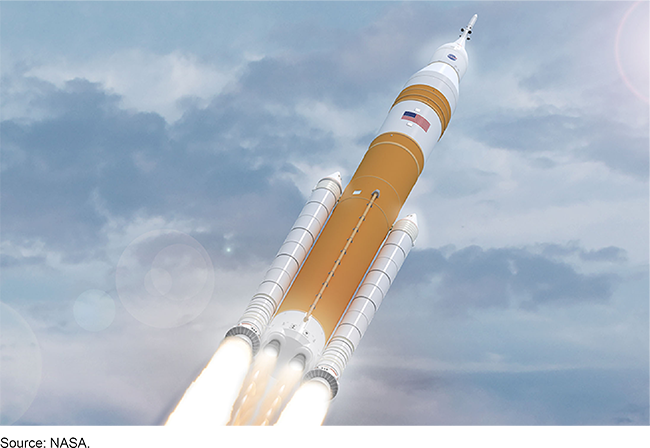Space Launch System: Cost Transparency Needed to Monitor Program Affordability
Fast Facts
Last year, NASA launched its Artemis I flight test using a Space Launch System rocket, or SLS.
NASA plans to spend billions of dollars to produce more rockets. It also needs to build progressively stronger versions of these rockets for use on Artemis missions into the 2030s.
Original SLS cost baselines, or committed costs, were tied to the launch of Artemis I. Without a baseline to track these production costs for upcoming missions, future program costs are less transparent and harder for NASA and Congress to monitor.
NASA should act on our prior recommendations to improve transparency and monitoring of this program.
Artist rendering of the SLS 1B, an evolved version of the Space Launch System that will enable future Artemis and Mars missions

Highlights
What GAO Found
The National Aeronautics and Space Administration (NASA) does not plan to measure production costs to monitor the affordability of its most powerful rocket, the Space Launch System (SLS). After SLS's first launch, Artemis I in November 2022, NASA plans to spend billions of dollars to continue producing multiple SLS components, such as core stages and rocket engines, needed for future Artemis missions. The program is also concurrently producing hardware for more capable versions of the SLS, the Block 1B and Block 2, for use on later missions.
Space Launch System Planned Block Upgrades

Because the original SLS version's cost and schedule commitments, or baselines, were tied to the launch of Artemis I, ongoing production and other costs needed to sustain the program going forward are not monitored. Instead, NASA created a rolling 5-year estimate of production and operations costs to ensure that the costs fit within NASA's overall budget. However, neither the estimate nor the annual budget request track costs by Artemis mission or for recurring production items. As a result, the 5-year estimate and the budget requests are poor measures of cost performance over time. In 2014, GAO recommended that NASA develop a cost baseline that captures production costs for the missions beyond Artemis I that fly SLS Block I. NASA intends to fly SLS Block I for Artemis II, planned for 2024, and Artemis III, planned for 2025. NASA partially concurred, but has not yet implemented this recommendation. A cost baseline would increase the transparency of ongoing costs associated with SLS production and provide necessary insights to monitor program affordability.
Senior NASA officials told GAO that at current cost levels, the SLS program is unaffordable. The SLS program developed a roadmap outlining short-term and long-term cost-saving strategies for future missions. For example, NASA plans to use contract types that shift cost risk from the government to the contractors and that achieve manufacturing efficiencies, but it is too early to determine the effects of such strategies. NASA is also considering long-term options, including purchasing future SLS launches and payload capabilities from a contractor who would own, operate, and integrate the SLS rocket.
Why GAO Did This Study
The SLS is the world's most powerful rocket and will enable NASA to return humans to the moon. NASA requested $11.2 billion in the fiscal year 2024 president's budget request to fund the program through fiscal year 2028, in addition to the $11.8 billion spent developing the initial capability. In November 2022, NASA successfully demonstrated SLS Block 1 during its Artemis I flight test. NASA intends to fly a series of increasingly difficult missions, including Artemis II—a crewed test flight—and Artemis III—a crewed lunar landing.
GAO's April 2023 high-risk report noted that NASA needed to improve transparency into the long-term costs and affordability of human spaceflight programs, including by establishing cost and schedule baselines for additional SLS capabilities.
A House report to an appropriations bill included a provision for GAO to review NASA's human exploration programs, including the SLS program. GAO assessed the extent to which (1) NASA has established plans to measure the SLS program costs post-Artemis I, and (2) the program has made progress with its plans to reduce projected SLS costs. GAO reviewed NASA documents and plans and interviewed agency officials.
Recommendations
GAO has made three past recommendations in this area—two of which GAO considers priority recommendations. GAO maintains that implementing these recommendations would provide necessary insight to improve program affordability.
